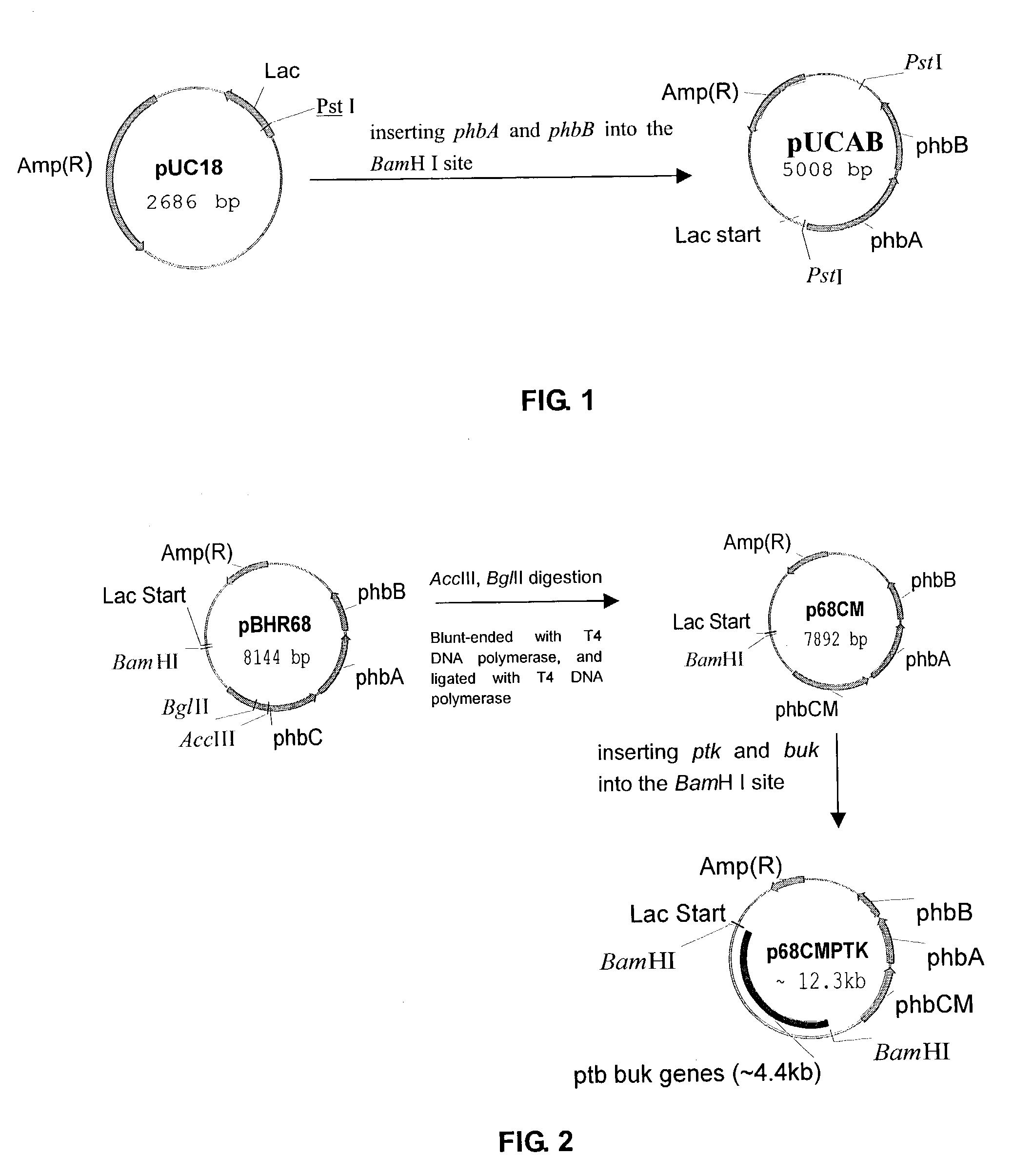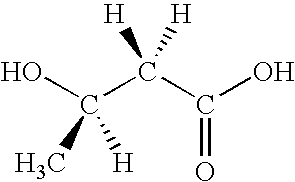Method for the production of D-(-)-3-hydroxybutyric acid by recombinant Escherichia coli
a technology of escherichia coli and d-(-)-3-hydroxybutyric acid, which is applied in the field of d-(-)-3-hydroxybutyric acid production by recombinant escherichia coli, can solve the problems of environmental pollution and high cost of d-(-)-3-hydroxybutyric acid production, and achieves simple techniques and high efficiency.
- Summary
- Abstract
- Description
- Claims
- Application Information
AI Technical Summary
Benefits of technology
Problems solved by technology
Method used
Image
Examples
example 1
The Construction of the Recombinant E. coli
Strain: E. coli HB101
Plasmid Construction:
[0018]1. As shown in FIG. 1, genes phbB and phbA were inserted into plasmid vector pUC18. The resulting plasmid pUCAB contained genes phbB and phbA downstream the lac promotor.
[0019]The plasmid was selected on Medium 1 which medium contains 10 g / l peptone, 5 g / l yeast extract, 10 g / l NaCl, 10 g / l glucose, and 60 μg / L ampicillin.
[0020]2. As shown in FIG. 2, plasmid pBHR68 containing operon phbCAB was digested with AccIII and BgIII, blunted with T4 DNA polymerase and further ligated with T4 DNA ligase to give plasmid pBHR68CM. Genes ptb and buk were inserted into BamHI-digested plasmid pBHR68CM to construct plasmid p68CMPTK. Genes ptb and buk are obtained from, e.g. plasmid pJC(Cary J. W., etc, J. Bacteriol 170, 4613-4618) with restriction enzyme BamHI.
[0021]Medium 2 was used to select the plasmids just mentioned above which medium contains 0.5 g / L (NH4)2SO4, 0.2 g / L MgSO4, 9.65 g / L NaHPO4·12H2O, 2.6...
example 2
[0026]This example demonstrates the synthesis of D-(−)-3-hydroxybutyric acid by recombinant E. coli in a fed-batch fermentation process under high temperature and low pH, using glucose as carbon source.[0027]Strain: Recombinant E. coli containing a single plasmid, such as plasmid p68CMPTK as prepared in Example 1.[0028]Plasmid transformation method: chemical transformation.[0029]Culture temperature: 42° C.[0030]Medium: Medium 2[0031]pH: 5.5[0032]Aeration: 3L / 3L medium / min[0033]Fermentation time: 36 hours[0034]Stirring speed: 150˜900 rpm
[0035]A fermentor containing sterilized broth was inoculated by a seed culture in an volume of 10%. The concentration of glucose was 40 g / L. Fermentation began with a stirring speed of 150 rpm and dissolved oxygen was set at 10%. Along with the growth of the cells, stirring speed was automatically increased until reaching 900 rpm, while the dissolved oxygen kept over 10% all the time. After fermentation, cells were centrifuged, and washed. The dry wei...
example 3
[0037]In this example, sucrose was used as carbon source and peptone as organic nitrogen source to synthesize D-(−)-3-hydroxybutyric acid by recombinant E. coli via a constant, continuous fed-batch fermentation under low culture temperature and high pH.[0038]Strain: Recombinant E. coli containing two plasmids.[0039]Plasmid transformation method: electrotransformation.[0040]Culture temperature: 28° C.[0041]Medium: Medium 3[0042]pH: 8.5[0043]Aeration: 2L / 3L medium / min[0044]Fermentation time: 48 hours[0045]Stirring speed: 150˜900 rpm
[0046]A seed culture was inoculated into a fermentor containing sterilized broth with in a volume of 10%. The concentration of beef extract was 10 g / L. The initial concentration of sucrose was 30 g / L. Fermentation began with a stirring speed of 150 rpm. The dissolved oxygen was controlled over 10% by adjusting the agitation. The concentration change of sucrose was monitored on-line during fermentation. When the sucrose concentration was consumed to reach 10...
PUM
| Property | Measurement | Unit |
|---|---|---|
| temperature | aaaaa | aaaaa |
| concentration | aaaaa | aaaaa |
| concentration | aaaaa | aaaaa |
Abstract
Description
Claims
Application Information
 Login to View More
Login to View More - R&D
- Intellectual Property
- Life Sciences
- Materials
- Tech Scout
- Unparalleled Data Quality
- Higher Quality Content
- 60% Fewer Hallucinations
Browse by: Latest US Patents, China's latest patents, Technical Efficacy Thesaurus, Application Domain, Technology Topic, Popular Technical Reports.
© 2025 PatSnap. All rights reserved.Legal|Privacy policy|Modern Slavery Act Transparency Statement|Sitemap|About US| Contact US: help@patsnap.com



